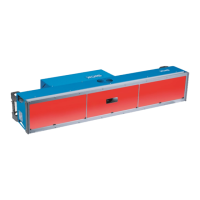PRODUCT DESCRIPTION 3
8011325/18IM/2020-07-02|SICK
Subject to change without notice
OPERATING INSTRUCTIONS | ICR880/890
3.2.2 Electrical installation requirements
To operate the camera system, the following are required:
• Supply voltage of the controller unit: AC 100 ... 264 V/50 ... 60 Hz
• Host computer with RS-232, RS-422 (RS-485 (MSC800 only)), Ethernet, PROFIBUS-DP
(MSC800), or fieldbus (SIC2000) data interface for further processing of the recorded
data.
• Connecting cables: see chapter 5.2.3 Pre-wired cables (overview).
3.2.3 Commissioning and configuration requirements
The system is configured via a configuration PC with the SOPAS configuration software
installed.
The configuration PC is connected to the controller unit via Ethernet.
3.3 Product features and functions
ICD880/890 camera
• CMOS line with 8,192 pixels (standard device)
• Dynamic focus position switching
• ICD880: lens with focal length of 80 mm, ICD890: lens with focal length of 135 mm
• Model-dependent read ranges (e.g., ICD890 standard device: 1.4 m to 3.0 m)
• Model-dependent image resolution (e.g., ICD890 standard device: 170 dpi to 350 dpi)
• Scanning frequency max. 19.1 kHz (standard device)/max. 30 kHz (high-speed device)
• Option to adapt to code print quality
• Evaluation range of sensor can be limited
• Image output (grayscale values: *.jpeg, *.tif)
Safety and ease-of-use
• Rugged, compact metal housing, enclosure rating max. IP 64, CE marking
• LED risk group RG 1 or RG 2, shut-down of the ICI890 LED illumination unit in the event
of a reading gate being active for an excessively long time or the output power being
exceeded, minimum switch-on duration: 3 s
• Automatic self-test on system start
• Diagnostic tools for system setup and (remote) system monitoring
• Configurable output of reading diagnostic data in two reading results formats
• Operating data polling, in case of error, output of error code if required
• Test string function can be activated to signal that the device is ready for operation
• Password-protected configuration mode
• Configured parameter values also saved (cloning) on the SD memory card (can be
removed when replacing the camera)
• Future-oriented thanks to firmware update (FLASH PROM) via data interface
• Future-oriented SOPAS-ET configuration software
• Wide supply voltage range
• Required maintenance or service work indicated via LED and system notification
• Camera or illumination unit can be individually replaced within ten minutes

